World-Famous or Legendary Muskie “Hotspots” – Part V
Category: article
Mar 4th, 2021 by Keith Worrall
Modified Mar 4th, 2021 at 8:20 PM
World-Famous or Legendary Muskie “Hotspots” – Part V
by Larry Ramsell, Muskellunge Historian
Part V and even this old timer is learning a lot! When I reached out to Pro Guide Spencer Berman about Lake St. Clair, he was easily able to handle a complex situation. Following are his response(s) for multiple “Hotspots” in the 275,200 acre “pond”, considered by many the sixth Great Lake, that lies between the U.S. State of Michigan and the Province of Ontario, Canada and is a virtual muskie factory!
Lake St. Clair/(Detroit River)
“Here is something I think will work for you. Obviously, St. Clair is a little different since we don’t have structure, however the general areas I named are pretty well known. The only one I left out that you might question is the Belle Hump and although it is a famous spot historically speaking, ever since the zebra mussels have gotten into the lake the water around there has gotten so clear that the last 15-20 years it has been a non-factor. Thought I would stick with spots that are still productive. Thank you.”
Captain Spencer Berman
Spencer’s Angling Adventures
419-410-0498
www.SpencersAnglingAdv.com
“Lake St. Clair, due to its complete lack of structure, doesn’t tend to have the “iconic” spot on the spots that other lakes get a reputation for. However, there are a few general areas of Lake St. Clair that have been producing trophy caliber fish for over a century. As a result of that continued success these areas have received household name recognition despite their lack of a specific bar or island.
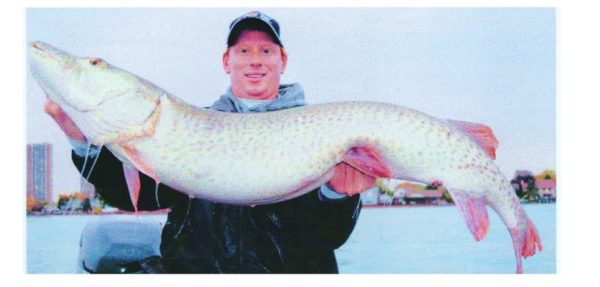
Spencer Berman with one of the many Giants he catches every year from Lake St. Clair’s “Hotspots”!
The Fingers
“The first spot that has gained wide recognition is called ‘The Fingers.’ This area is located outside the Thames River and got its name due to the finger like contour that the old maps and original GPS chips had overtop of it. There is no actual contour here at all; instead, it is a flat hard bottom area. This bottom content, however, has made it a phenomenal location for gizzard shad to pile up and that combined with the in-flow of the Thames River makes it a constant hotspot.
The Red Barn
“The second iconic spot on this storied musky lake is the “Red Barn.” This is located on the south shore west of Belle River. At one point the south shore wasn’t widely developed and the red barn on the shoreline stood out with the rest being fields and what not. The area out from this barn was, and still is, a muskie mecca with tons of large fish being registered here.
The Sturgeon Hole; Peche Island; The Sand Piles
“Another iconic muskie spot is located where Lake St. Clair meets the Detroit River. This area has many different names including “The Sturgeon Hole, Peche Island (well known, and written about by Muskie Legend, the late Homer LeBlanc) , and The Sand Piles.” It is often widely noticed in muskie pictures the world over due to the presence of several large and tall gravel and sand piles on its shoreline. It is the first deep cut of the Detroit River coming from the lake and although it holds some fish all year round it is widely known as a mostly fall hotspot.”
While we are on Lake St. Clair/(Detroit River), I will insert the “Hotspots” that Homer LeBlanc most referred to in his book “Muskie Fishing Fact And Fancy Lore And Lures”, a trolling route, which relates to Lake St. Clair and the Detroit River and may even be in the area previously mentioned by Spencer.
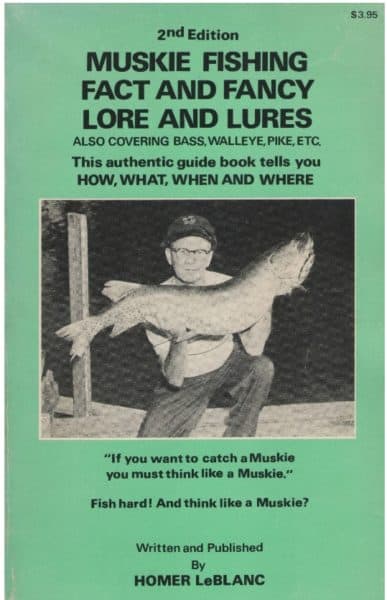
Scott Middle Grounds; Dumping Grounds /Detroit River
“…I confined my muskie fishing to the Scott Middle Grounds in the Detroit River. I would troll the American shoreline up to the Dodge Channel area just 2 miles north of the trailer park and troll eastward of the park for a couple of miles to what is known as the Dumping Grounds, just a few miles away. All real good muskie waters.”
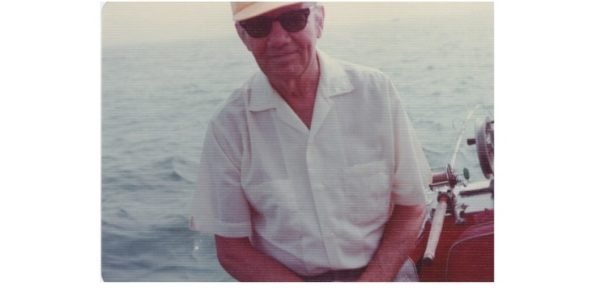
Captain Homer LeBlanc when the author fished Lake St. Clair with him in the late 1970’s. He was a Great ambassador of the sport!
Homer further described the Scott Middle Grounds: …”a shallow area between Belle Isle and the mainland, about ¾ miles across. Right within the city limits of Detroit. It’s an ideal spawning grounds and is infested with muskies during May and June…”
We now move on to one of my bailiwicks; The Turtle-Flambeau Flowage in Iron County, Wisconsin, between Mercer and Park Falls. Here is the site where the heaviest muskie ever caught in Wisconsin by a woman was captured and it also produced the largest muskie caught in Wisconsin in 1971 (which will appear in Part V). It also produced another 50-pound giant, also caught by a woman (which will appear in Part VIII)! These three captures created three more Legendary muskie “Hotspots”. The first:
Rita’s Rocks
The late Rita Hillenbrand was no ordinary muskie angler. According to her long-time guide, the late Dick Sleight, likely the most productive guide in the State for muskies over 40 pounds, Rita apparently had a knack for knowing when and where muskies were going to hit! She worked as hard as any man and helped create her own luck. The number of huge muskies she caught would shame most male muskie anglers.
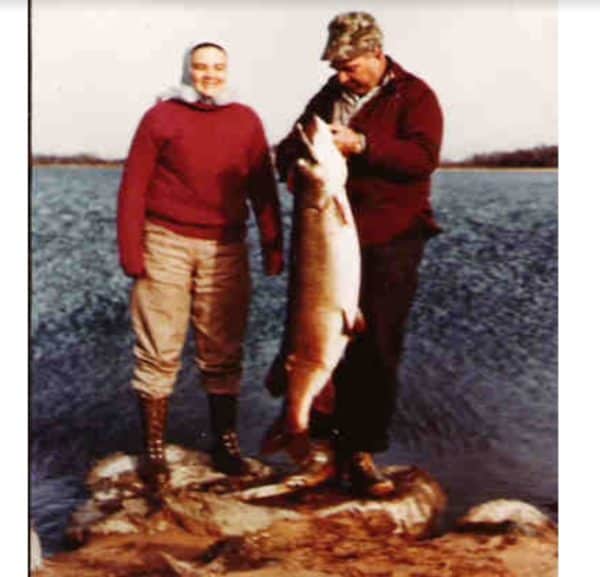
Huge guide Dick Sleight makes Rita’s giant appear small.
Rita and Dick are standing on “Rita’s Rocks”.
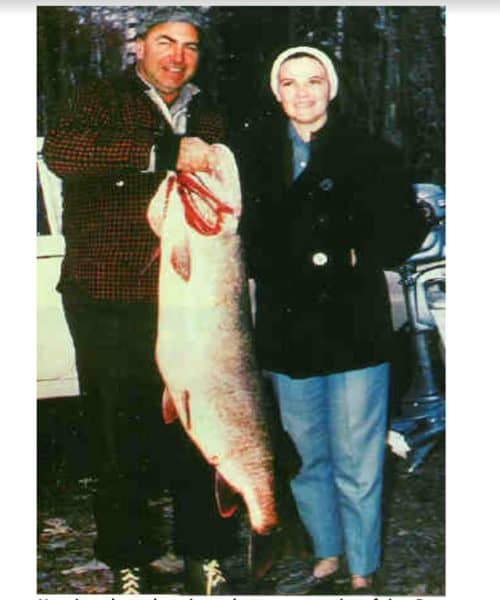
Here is a photo that gives a better prospective of size. Ray Hillenbrand photos, courtesy IGFA.
Rita Hillenbrand –54 ½ inches, 52-pounds 8¾-ounces – 1969
What better happening than the capture of a 50 plus pound muskie to name a muskie “Hotspot”! As the story unfolds, you will note that “Rita’s Rocks” are in the Baraboo Lake section of the Flambeau side of the Turtle-Flambeau Flowage. Oh, where to start with this wonderful story of a special little Lady, a huge guide and a giant muskie?
I ran into Dick at the Milwaukee sports show and had a chance to discuss Rita’s fish with him. According to Dick she had that “something special” and caught a LOT of big muskies. A most cordial gentleman he was and upon returning home he provided me with documentation on another Lady caught 50-pound muskie caught from the Flambeau Flowage.
The late Peter Haupt provided me with the accurate weight of Rita Hillenbrand’s brute of 52-pounds 8 ¾-ounces. According to her husband Ray in an article he wrote, The Musky Guide and His Special Musky Fishing Lady in the December/January 1998 issue of Musky Hunter magazine, the fish was 55-inches long and 53-pounds, likely a “rounding up” of both dimensions. Ray also told the story of the capture of Rita’s giant. Following are excerpts from that story:
“The first day of the trip, after fishing the shoreline in the morning, we had lunch on the island from which Dick had seen the big muskie the previous week. It was very cold and we built a fire. Rita put out her line with a very large, live sucker while we ate lunch. After a short while I checked the pole and said it was snagged. I worked it out of the snag and when the sucker was brought in it was badly cut up, having been in the mouth of the big muskie rather than on a snag. When Rita saw this she was upset and told me to leave her pole alone and that she would handle any activity on it in the future. We fished the rest of the day without any fish.
“The next day we went back to Baraboo Lake and Rita had the
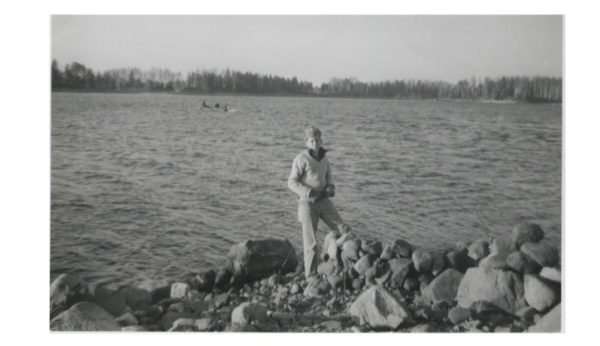
The author on Rita’s Rocks on a late fall muskie trip long ago.
feeling that the big fish was going to hit again. When we got to the island from which the fish was seen the day before, Rita said, “Put me on shore, this is where I fish today. This was unusual for she always fished out of a boat and only fished off land during lunchtime. She had us build her a fire and we put out the live sucker for her. Dick gave her a white towel and told her that if she got a hit to wave the towel and we’d come get her. We left Rita on the shore with her rod and towel and we fished other parts of the lake.
“Later we went back to the island for lunch and to set up a second rod for her. After lunch, Dick and I started to fish about a mile from where Rita was on shore. After a short time of fishing Dick felt that we were too far away to see her waving the white towel should she get a hit. We started to move the boat closer and we could see her waving the white towel and yelling, “Fish, fish.” We picked her up and she immediately tightened the line so she could feel the muskie, and said she thought the musky had swallowed the sucker and was getting ready to throw it. Suddenly, the line started to go out fast on her reel and rise in the water, a sure sign it was making its run to throw the sucker.
“Rita understood this and after tightening her line more, set the hook. With that her pole bent into a half circle and shortly thereafter the water exploded and the musky surfaced. It was so big that it could only lift its head out of the water just beyond the gill covers. It thrashed its head sideways many times on top of the water trying to throw the sucker, causing a large amount of froth and waves. It then sounded and gave Rita a real fight for about 20 minutes. She had quite an experience because all the time the fish was fighting she had to thumb the spool to keep the right amount of pressure on the fish as she did not have an automatic drag on her reel to do this for her.
“The muskie surfaced two more times, thrashing its head on top of the water. Its most rapid run occurred the first time it saw the boat. The muskie immediately dove and went under the boat causing Rita to work her bent pole around the front of the boat to the opposite side.
“Finally Rita had the fish played out and next to the boat where Dick could get at it. It was too big for Dick’s large net so he grabbed a piece of driftwood which Rita had picked up from the shore and used it as a club to stun the fish. Then he put the net under the muskie as best he could, causing it to thrash in the net – it looked like a large pig without legs! Finally Dick hoisted it into the boat. When it was over, Rita sat down, shaking, and looked at the fish and said, “I knew it, I knew it.” We all just sat there, amazed and happy, admiring the monster. When it sunk in as to what Rita had caught we packed our gear and headed home. Fishing was over for the day.
“…Later that evening, Dick told Rita she would probably slack off from muskie fishing now that she caught the big one. She said, “Not me, I’m greedier now than ever to catch more big ones.” In subsequent years she and Dick caught several over 40 pounds but not another 50-pounder.
“…Rita and Dick were some of the first people to catch and release muskies. She released several fish that were well over 50 inches in length. The first year that the Minocqua-Woodruff, Wisconsin, area had a musky release contest she won it with the release of a 53-inch musky.
“Rita died in 1991 at age 55 from cancer, but her spirit and energy are continuously felt by those who knew her. We just wish we had her sixth sense for when the big one was around…”
What was not written in that article is the fact that Ray had been shooting film of the capture of Rita’s fish. Some of that footage appears in a Documentary film Ray had made by Omaha Public Television entitled “Hooked”. It is narrated by country singer Randy Travis and is basically a story of Guide Dick Sleight’s big fish days with Ray and Rita and several other of Dick’s clients who captured giant muskies over the years.
And so, the “Rita’s Rocks” Legend was born!
I am sure that there are many other Hotspots that I am not aware of even though I have fished muskies in 23 states and 2 provinces of Canada over the past 65 years. Any reader who knows of one or more Legendary or famous Hotspots, please let me know with a write-up of same and supporting photos if available and I will include them in a follow-up article(s).
Send it to me at: larryramsell@hotmail.com
Thank you!